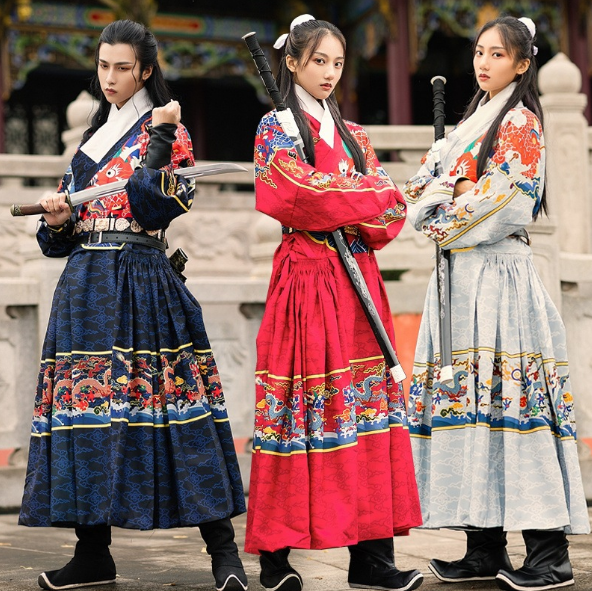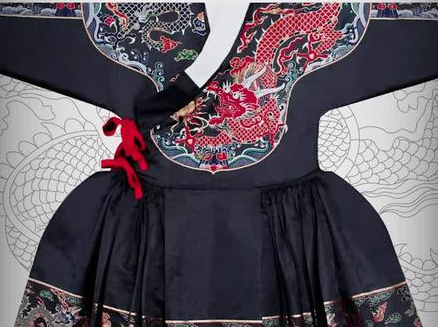Historical Background
Origins of the Flying Fish Suit
The Flying Fish Suit first emerged in ancient Chinese culture, a symbol of status among court officials. Craftsmen meticulously designed these suits, selecting fabrics that reflected the wearer’s rank. Each suit, ornate and intricate, represented a fusion of artistry and social hierarchy. Over time, the design subtly changed, adapting to the evolving tastes of the ruling dynasties.

Evolution of the Python Robe
In contrast, the Python Robe traces its roots to imperial China, worn exclusively by emperors and high-ranking nobles. Initially, these robes featured real python skin, a testament to the emperor’s supreme authority. As centuries passed, the Python Robe evolved, embracing symbolism through embroidered patterns, often showcasing dragons and other imperial motifs. This evolution mirrored changes in imperial power and cultural values.
This detailed exploration provides insight into the historical significance and transformations of both the Flying Fish Suit and the Python Robe, reflecting their deep roots in Chinese history and culture.
Physical Characteristics
Fabric and Material Differences
The Flying Fish Suit typically features silk, renowned for its smooth texture and lustrous sheen. Artisans often incorporate gold or silver threads to enhance the suit’s elegance. In contrast, early versions of the Python Robe utilized actual python skin, symbolizing imperial power. Modern interpretations, however, often use silk or brocade, embroidered with python patterns for a symbolic representation.
Color and Pattern Variations
Color plays a crucial role in distinguishing these garments. The Flying Fish Suit often appears in vibrant colors like red or blue, adorned with embroidered patterns of birds or oceanic elements. The Python Robe, on the other hand, traditionally showcases darker hues, predominantly black or dark green, with intricate golden dragon motifs or phoenix designs, embodying imperial authority and mythological significance.
These details highlight the distinct physical attributes of the Flying Fish Suit and Python Robe, showcasing their unique fabric choices, colors, and patterns, deeply rooted in Chinese artistic traditions.
Symbolic Significance
Cultural Meaning of the Flying Fish Suit
The Flying Fish Suit symbolizes rank and achievement in Chinese officialdom. Each element, from the fabric to the patterns, conveys a specific rank and status. For instance, a suit with gold threads typically denotes a higher position. This attire also reflects the wearer’s virtues, such as loyalty and integrity, deemed essential in Chinese bureaucracy.
Symbolism Behind the Python Robe
The Python Robe, steeped in imperial symbolism, represents supreme power and authority in ancient China. The use of python skin or motifs signifies fearlessness and strength, qualities attributed to the emperor. Moreover, the inclusion of dragon patterns elevates the robe’s status, as dragons symbolize imperial power and divine right in Chinese mythology.
Through these garments, ancient Chinese culture communicated social hierarchy and conveyed profound symbolic meanings, highlighting the intricate relationship between attire and status in historical contexts.
Usage in Ceremonies and Events
Role of the Flying Fish Suit in Traditional Events
Officials wore the Flying Fish Suit at important state events and ceremonies, symbolizing their status and roles. During the Ming and Qing dynasties, these suits were especially prominent at the imperial court. The suit’s design, varying by rank, ensured a visual representation of the bureaucratic hierarchy. High-ranking officials donned more ornate suits at key events like the emperor’s birthday or during the Lunar New Year celebrations.
Significance of the Python Robe in Ceremonial Contexts
The Python Robe was a centerpiece in major imperial ceremonies, exclusively worn by the emperor. Its use was common during the most significant events, like coronation ceremonies, royal weddings, and the annual Imperial Ancestral Temple rites. The robe, symbolizing divine authority, reinforced the emperor’s exalted position in these high-profile events.
In these contexts, both the Flying Fish Suit and the Python Robe played crucial roles in visually structuring and reinforcing the social and political order of traditional Chinese society, especially during ceremonial occasions.

Modern Adaptations and Influence
Contemporary Interpretations of the Flying Fish Suit
Today, designers often reinterpret the Flying Fish Suit in modern fashion, blending traditional motifs with contemporary styles. These adaptations appear in formal wear, showcasing intricate embroidery and vibrant colors, reminiscent of the original suits. The suits now symbolize a blend of historical elegance and modern sophistication, often seen in high-end fashion shows and cultural events, linking past and present in Chinese fashion.
Python Robe’s Influence on Modern Fashion
The Python Robe has also inspired modern designers, who infuse its elements into luxury clothing lines. The robe’s iconic dragon motifs and luxurious fabrics find new life in contemporary designs, often in evening gowns and haute couture collections. This influence extends beyond China, impacting global fashion trends and highlighting the enduring appeal of imperial aesthetics.
These modern adaptations showcase how historical garments like the Flying Fish Suit and Python Robe continue to influence and enrich contemporary fashion, blending tradition with innovation in a constantly evolving cultural landscape.







